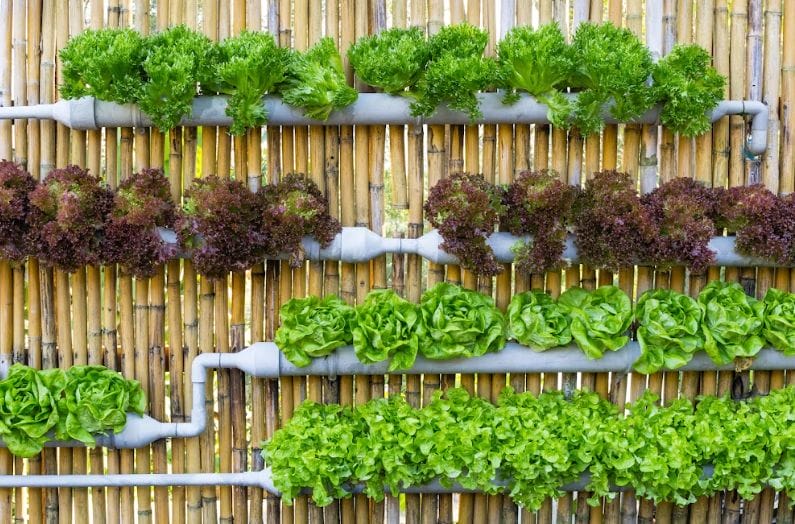 A vertical garden is a vertically suspended system that takes advantage of back walls, western walls, and to some extent, cross beams. They range from soil systems like repurposed hanging shoe racks and bottle systems filled with soil and dripping into each other to hydroponic PVC systems, grow towers, stacked pots, and hanging planters. The primary considerations are weight and shading. You want your vertical system to allow light for other plants. You want it to squeeze the last light rays and maximize your growing space. This is why you put these on your western wall or back wall, so they don’t block light for other plants. Living green walls can thrive for harvest after harvest and keep you in an abundance of food throughout your growing season.
Hanging gardens or pots also may only shade the plants below for a period of the daytime. Many plants don’t need or want full sun, so placing hanging plants above can protect plants below when done strategically. Balcony and deck railings are also a great use of space, but these can also block light to growing areas. Placing them on the western side will result in them receiving the early sunlight the plants need but subdued light, probably after noon. When you think about your outdoor garden, think about it both horizontally and vertically.
Here’s a question to ask yourself, though. Can you bring that vertical garden indoors? One of your walls might be perfect for a growing wall. Looking at a wall of living green can have a calming effect on a person, all the while providing you with a more pest-free gardening experience and easy access to your food regardless of the season. Many people use indoor grow towers and hydroponic systems for this very reason.
HYDROPONICS
A vertical garden is a vertically suspended system that takes advantage of back walls, western walls, and to some extent, cross beams. They range from soil systems like repurposed hanging shoe racks and bottle systems filled with soil and dripping into each other to hydroponic PVC systems, grow towers, stacked pots, and hanging planters. The primary considerations are weight and shading. You want your vertical system to allow light for other plants. You want it to squeeze the last light rays and maximize your growing space. This is why you put these on your western wall or back wall, so they don’t block light for other plants. Living green walls can thrive for harvest after harvest and keep you in an abundance of food throughout your growing season.
Hanging gardens or pots also may only shade the plants below for a period of the daytime. Many plants don’t need or want full sun, so placing hanging plants above can protect plants below when done strategically. Balcony and deck railings are also a great use of space, but these can also block light to growing areas. Placing them on the western side will result in them receiving the early sunlight the plants need but subdued light, probably after noon. When you think about your outdoor garden, think about it both horizontally and vertically.
Here’s a question to ask yourself, though. Can you bring that vertical garden indoors? One of your walls might be perfect for a growing wall. Looking at a wall of living green can have a calming effect on a person, all the while providing you with a more pest-free gardening experience and easy access to your food regardless of the season. Many people use indoor grow towers and hydroponic systems for this very reason.
HYDROPONICS
 Hydroponics is the technique of growing plants using a water-based nutrient solution rather than soil and can include an aggregate substrate or growing media, such as vermiculite, coconut coir, or perlite. These systems range from grow towers to grow walls, from small farmers to hobbyists to large commercial enterprises. This is one of the few options for some northern regions because of such a short growing season. The problems with this method are providing nutrients, preventing algae or gnats, the system’s weight, the electricity needed to circulate water, and the need to provide supplemental light. These systems can range from windowsill setups to towers to whole walls and can be deployed outdoors and indoors.
Purchasing a ready-made system can be phenomenally expensive. With a bit of craftiness, you can build your own, which we will do in a later video. Building your own is the route most people take because the cost is still so high. Fortunately, the materials are much cheaper today than in years past. The prices of PVC may have gone up, but the price of grow lights and growing media like vermiculite, coconut coir, or expanded clay have all gone down. Thanks to the home growers of cannabis and tomatoes, you will find many more hydroponic stores in your area and probably a few deals on used equipment on your local exchange.
One grow tower of lettuce and kale planted over several weeks will provide you with more greens than a person can possibly eat by themself. Keep that in mind as you plan your setup. Maybe it is an opportunity to trade or partner with others. When you think of hydroponic, vertical growing in your space, consider the range of options available to you to maximize your space and yield.
AQUAPONICS
Hydroponics is the technique of growing plants using a water-based nutrient solution rather than soil and can include an aggregate substrate or growing media, such as vermiculite, coconut coir, or perlite. These systems range from grow towers to grow walls, from small farmers to hobbyists to large commercial enterprises. This is one of the few options for some northern regions because of such a short growing season. The problems with this method are providing nutrients, preventing algae or gnats, the system’s weight, the electricity needed to circulate water, and the need to provide supplemental light. These systems can range from windowsill setups to towers to whole walls and can be deployed outdoors and indoors.
Purchasing a ready-made system can be phenomenally expensive. With a bit of craftiness, you can build your own, which we will do in a later video. Building your own is the route most people take because the cost is still so high. Fortunately, the materials are much cheaper today than in years past. The prices of PVC may have gone up, but the price of grow lights and growing media like vermiculite, coconut coir, or expanded clay have all gone down. Thanks to the home growers of cannabis and tomatoes, you will find many more hydroponic stores in your area and probably a few deals on used equipment on your local exchange.
One grow tower of lettuce and kale planted over several weeks will provide you with more greens than a person can possibly eat by themself. Keep that in mind as you plan your setup. Maybe it is an opportunity to trade or partner with others. When you think of hydroponic, vertical growing in your space, consider the range of options available to you to maximize your space and yield.
AQUAPONICS
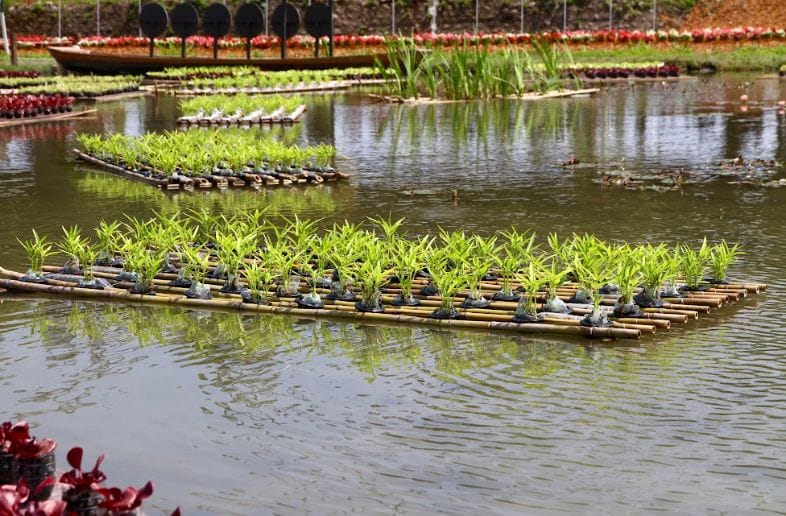 For the slightly more daring, there is aquaponics—this couples aquaculture with hydroponics. You produce fish for protein which in turn makes nutrients for the plants. Automatic recirculating systems do not require much monitoring or measuring, as they, when functioning correctly, create a symbiotic relationship between the plants and fish. The fish benefit from the filtered and oxygenated water. The plants benefit from the waste materials of the fish. Modern versions of these setups can be deployed outdoors, even in a small patio space. Many viewers sent us pictures of their systems in their garages or backyards– some elaborate and some simple additions circulated off their fish tanks with some basic pumps.
It is not a new science. Hydroculture was used quite extensively by the Aztecs. The Chinese used loach, swamp eels, carp, and pond snails in their rice patties. Aquaponics was developed everywhere plants were cultivated alongside bodies of water teeming with life. It’s more like we humans learned what mother nature was naturally doing and tried to capture and contain some little piece of that process. Typically the plants grow right on top of the water. Your chief concerns with this method are the creatures, the water, and the weight of the water. Tilapia breed fast. Just one female will typically produce about 200-1000 eggs per spawn, and she’ll spawn every 4-5 weeks. That’s a lot of population control you have to think about. Something like koi or other carp won’t breed as fast, but they also aren’t your first choice for consumption either. Minnows, guppies, or goldfish might breed and produce quickly if conditions are right, but if you plan on eating the fish for protein, you probably would have to get pretty creative.
Feeding those fish and keeping them healthy can also be a challenge. That amount of water is a challenge too. Some apartments allow tanks up to 25 gallons while others limit it to 2 gallons. Some have no restrictions at all. Leaks can do damage, and a gallon of water is 8 and 1/3 pounds. So, while the method is fantastic and, in many ways, self-sustaining, it comes with more than a few considerations.
AEROPONICS
For the slightly more daring, there is aquaponics—this couples aquaculture with hydroponics. You produce fish for protein which in turn makes nutrients for the plants. Automatic recirculating systems do not require much monitoring or measuring, as they, when functioning correctly, create a symbiotic relationship between the plants and fish. The fish benefit from the filtered and oxygenated water. The plants benefit from the waste materials of the fish. Modern versions of these setups can be deployed outdoors, even in a small patio space. Many viewers sent us pictures of their systems in their garages or backyards– some elaborate and some simple additions circulated off their fish tanks with some basic pumps.
It is not a new science. Hydroculture was used quite extensively by the Aztecs. The Chinese used loach, swamp eels, carp, and pond snails in their rice patties. Aquaponics was developed everywhere plants were cultivated alongside bodies of water teeming with life. It’s more like we humans learned what mother nature was naturally doing and tried to capture and contain some little piece of that process. Typically the plants grow right on top of the water. Your chief concerns with this method are the creatures, the water, and the weight of the water. Tilapia breed fast. Just one female will typically produce about 200-1000 eggs per spawn, and she’ll spawn every 4-5 weeks. That’s a lot of population control you have to think about. Something like koi or other carp won’t breed as fast, but they also aren’t your first choice for consumption either. Minnows, guppies, or goldfish might breed and produce quickly if conditions are right, but if you plan on eating the fish for protein, you probably would have to get pretty creative.
Feeding those fish and keeping them healthy can also be a challenge. That amount of water is a challenge too. Some apartments allow tanks up to 25 gallons while others limit it to 2 gallons. Some have no restrictions at all. Leaks can do damage, and a gallon of water is 8 and 1/3 pounds. So, while the method is fantastic and, in many ways, self-sustaining, it comes with more than a few considerations.
AEROPONICS
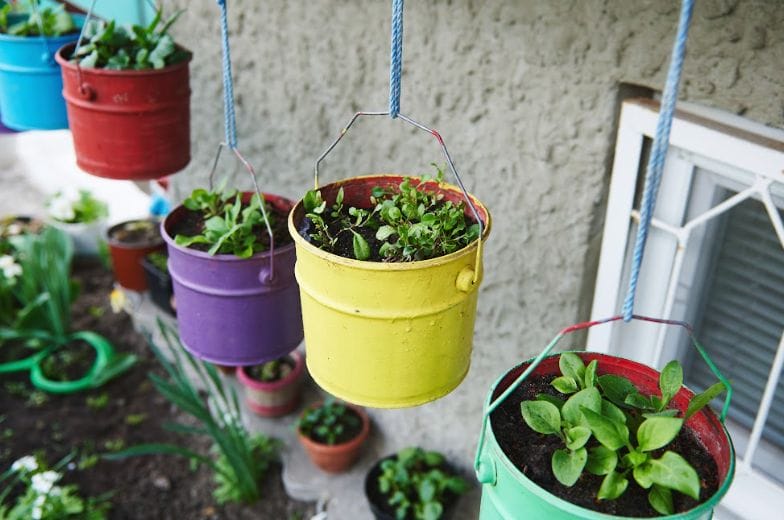 Aeroponics is a plant-cultivation technique in which the roots hang suspended in the air while a nutrient solution is delivered to them in the form of a fine mist. It grows plants in the air or mist environment without soil or an aggregate medium. These have become very popular for window sill and small kitchen counter setups, but the method is also used in large-scale operations and even by NASA in space. The basic principle of aeroponic growing is to grow plants suspended in a closed or semi-closed environment by spraying the plant’s dangling roots and lower stem with an atomized or sprayed nutrient-rich water solution of 5–50 micrometers micro-droplets.
Some of the drawbacks of this method are the constant mist needed and the electrical requirements for producing that mist. Roots are very sensitive parts of plants and do not like air exposure. Also, the humid, misty environment can result in an infestation of bugs if the system isn’t carefully closed off from outside exposure. Sealing it off too completely can require the grower also to have to manage oxygen and CO2 levels in the system. There is also a need for supplemental grow lights. Because of these concerns, the aeroponic method is often combined with aspects of hydroponics, and other grow materials. There are low and high-pressure versions of this method that range from small to massive commercial versions.
If you have a little bit of scientist and a little bit of engineer in you, this can be very rewarding. We have seen everything from lettuce to potatoes grown in this manner. There’s much to learn with this method.
CONTAINER GARDENING
Aeroponics is a plant-cultivation technique in which the roots hang suspended in the air while a nutrient solution is delivered to them in the form of a fine mist. It grows plants in the air or mist environment without soil or an aggregate medium. These have become very popular for window sill and small kitchen counter setups, but the method is also used in large-scale operations and even by NASA in space. The basic principle of aeroponic growing is to grow plants suspended in a closed or semi-closed environment by spraying the plant’s dangling roots and lower stem with an atomized or sprayed nutrient-rich water solution of 5–50 micrometers micro-droplets.
Some of the drawbacks of this method are the constant mist needed and the electrical requirements for producing that mist. Roots are very sensitive parts of plants and do not like air exposure. Also, the humid, misty environment can result in an infestation of bugs if the system isn’t carefully closed off from outside exposure. Sealing it off too completely can require the grower also to have to manage oxygen and CO2 levels in the system. There is also a need for supplemental grow lights. Because of these concerns, the aeroponic method is often combined with aspects of hydroponics, and other grow materials. There are low and high-pressure versions of this method that range from small to massive commercial versions.
If you have a little bit of scientist and a little bit of engineer in you, this can be very rewarding. We have seen everything from lettuce to potatoes grown in this manner. There’s much to learn with this method.
CONTAINER GARDENING
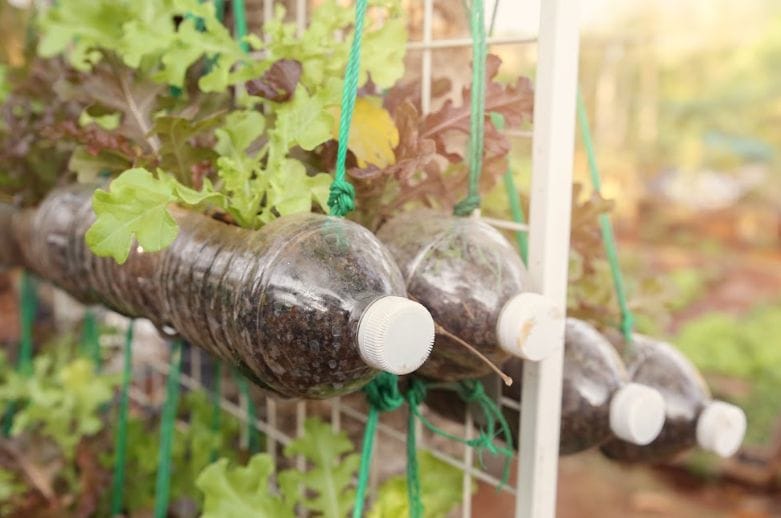 Most of us will take a hard pass on the complicated science-heavy methods of the techniques we mentioned earlier in favor of good, old-fashioned soil and containers. This will range from potted plants to stacked garden towers. The growing medium is soil or potting soil. If you plan to garden this way, realize that your soil can quickly be depleted of nutrients. You will need to supplement the nutrients with either fertilizer or compost materials. You are also susceptible to fungus and infestations: however, having an abundance of direct sunlight reduces the possibility of these. You also have to realize that these containers will have weight. You want containers that are within the bounds of your area’s maximum load.
Containers also need to drain somewhere. Will they run off into a plant saucer or trough? As we demonstrated in our sweet potato video, a self-wicking system will allow you to control water levels while also getting vital nutrients directly to the root system. With any container system, you’re taking a piece of the Earth and containing it to serve your needs. That brings with it some challenges, but it also brings plenty of rewards. Controlling and coaxing the environment you create to get maximum results can be rewarding and can provide you with an abundance of living food. Read the blog in this series on soil before going this route. We know a video on soil doesn’t sound very exciting, but we promise you we put in a tremendous amount of knowledge and insight into that topic to make it as concise as possible and give you what you need to be successful. Do check that out.
GROW TENTS
Most of us will take a hard pass on the complicated science-heavy methods of the techniques we mentioned earlier in favor of good, old-fashioned soil and containers. This will range from potted plants to stacked garden towers. The growing medium is soil or potting soil. If you plan to garden this way, realize that your soil can quickly be depleted of nutrients. You will need to supplement the nutrients with either fertilizer or compost materials. You are also susceptible to fungus and infestations: however, having an abundance of direct sunlight reduces the possibility of these. You also have to realize that these containers will have weight. You want containers that are within the bounds of your area’s maximum load.
Containers also need to drain somewhere. Will they run off into a plant saucer or trough? As we demonstrated in our sweet potato video, a self-wicking system will allow you to control water levels while also getting vital nutrients directly to the root system. With any container system, you’re taking a piece of the Earth and containing it to serve your needs. That brings with it some challenges, but it also brings plenty of rewards. Controlling and coaxing the environment you create to get maximum results can be rewarding and can provide you with an abundance of living food. Read the blog in this series on soil before going this route. We know a video on soil doesn’t sound very exciting, but we promise you we put in a tremendous amount of knowledge and insight into that topic to make it as concise as possible and give you what you need to be successful. Do check that out.
GROW TENTS
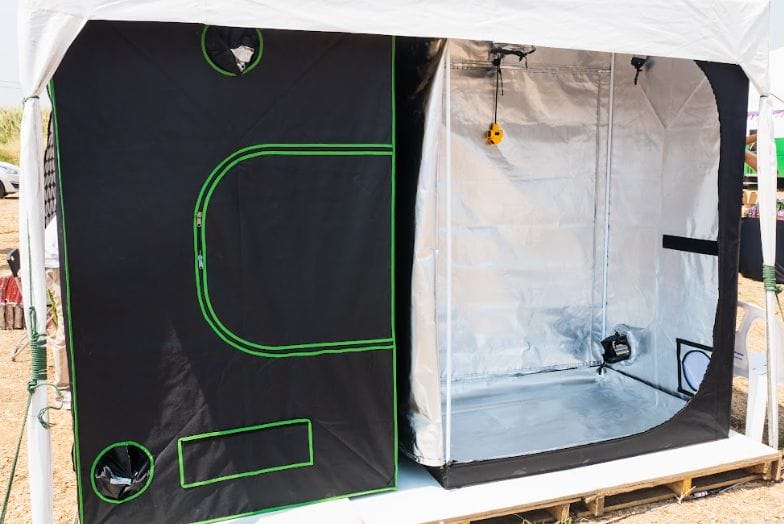 If you want total control over the environment, you can use an indoor grow tent or repurpose a room or closet. The challenges with this method are weight, light, temperature regulation, and air circulation. Plants need air, just like we do, so they don’t suffocate. There is a lot to control and regulate in this type of setup. The advantage is that you are not confined to the whims of weather or the shortened sunlight of some seasons. You can grow year-round with UV-A, B, and C bulbs over your plants.
What you grow is only known to you, so there is less chance nosy neighbor or a homeowner’s association will complain. Naturally, your electrical requirements will go up, and you must move a lot of equipment and materials in and out of your house and grow area. While these are great solutions for smaller but continual yields, they require more attention to detail and a dedicated and unmovable space. Also, without adequate ventilation to the outside, your home can take on a very earthy smell depending upon your growing materials and plant choices. Still, this method has been successful for small-space cultivation in apartments and dorm rooms worldwide.
BAG & STRAWBALE
If you want total control over the environment, you can use an indoor grow tent or repurpose a room or closet. The challenges with this method are weight, light, temperature regulation, and air circulation. Plants need air, just like we do, so they don’t suffocate. There is a lot to control and regulate in this type of setup. The advantage is that you are not confined to the whims of weather or the shortened sunlight of some seasons. You can grow year-round with UV-A, B, and C bulbs over your plants.
What you grow is only known to you, so there is less chance nosy neighbor or a homeowner’s association will complain. Naturally, your electrical requirements will go up, and you must move a lot of equipment and materials in and out of your house and grow area. While these are great solutions for smaller but continual yields, they require more attention to detail and a dedicated and unmovable space. Also, without adequate ventilation to the outside, your home can take on a very earthy smell depending upon your growing materials and plant choices. Still, this method has been successful for small-space cultivation in apartments and dorm rooms worldwide.
BAG & STRAWBALE
 If you are dealing with an outdoor space, it’s not uncommon for people to plant directly into a straw bale with dirt added into the top center or slits in a bag of commercial soil or potting soil. You must have drainage for both methods to keep your grow medium from turning into a big rotting mess. With the straw bale method, you are counting on some decomposition of the straw to provide nutrients to the plant. These can be breeding grounds for bugs too. That’s the reason we only suggest this method for outside small grow areas. We do have a straw bale, so we will probably do a future video demonstrating this technique. For now, just realize that it is an option many people use.
The potato tower we demonstrated in an earlier video is a variation that combines both these methods in a wire frame. Attention to drainage is a concern, and the weight of the materials is a concern. It has to be placed for the optimal sun. With any container or vertical system, the ability to move or rotate it on wheels is always beneficial.
As you consider these different methods in your grow space, consider the light, weight, water, space, and container. Let that guide your decisions on what you grow. When you know what you want to grow, consider the size of a successful, mature plant. If you plant a sweet potato in a small pot, you will get a great vine, but any sweet potato won’t make even a side dish for a meal. If you plant corn, a typical corn plant can be anywhere from five feet to 12 feet tall, and it wants its roots to go an average of 6 feet deep. Do you have enough height for that, or will it block out all your other plants? Is there enough width to accommodate that root that wants to run so deep? Can the plants you are growing be planted tightly together, or do they need significant spacing from each other? You can tweak some of these requirements by giving plants their own containers. Also, consider the light and water requirements of your plants. With any of these various growing methods, different plants may require supplementation of light, nutrients, or more or less water than other plants.
Likely, you will want to combine several methods for your area to maximize your growing capabilities. There are other methods of growing that we don’t cover here because of time, but we wanted to give you a quick overview of the seven most common methods. We will explore some of them in far greater, hands-on detail in future blogs as we establish my three growing areas. Others, we will let you explore further. If you have a method we didn’t cover here, please share it in the comments below.
As always, stay safe out there.
If you are dealing with an outdoor space, it’s not uncommon for people to plant directly into a straw bale with dirt added into the top center or slits in a bag of commercial soil or potting soil. You must have drainage for both methods to keep your grow medium from turning into a big rotting mess. With the straw bale method, you are counting on some decomposition of the straw to provide nutrients to the plant. These can be breeding grounds for bugs too. That’s the reason we only suggest this method for outside small grow areas. We do have a straw bale, so we will probably do a future video demonstrating this technique. For now, just realize that it is an option many people use.
The potato tower we demonstrated in an earlier video is a variation that combines both these methods in a wire frame. Attention to drainage is a concern, and the weight of the materials is a concern. It has to be placed for the optimal sun. With any container or vertical system, the ability to move or rotate it on wheels is always beneficial.
As you consider these different methods in your grow space, consider the light, weight, water, space, and container. Let that guide your decisions on what you grow. When you know what you want to grow, consider the size of a successful, mature plant. If you plant a sweet potato in a small pot, you will get a great vine, but any sweet potato won’t make even a side dish for a meal. If you plant corn, a typical corn plant can be anywhere from five feet to 12 feet tall, and it wants its roots to go an average of 6 feet deep. Do you have enough height for that, or will it block out all your other plants? Is there enough width to accommodate that root that wants to run so deep? Can the plants you are growing be planted tightly together, or do they need significant spacing from each other? You can tweak some of these requirements by giving plants their own containers. Also, consider the light and water requirements of your plants. With any of these various growing methods, different plants may require supplementation of light, nutrients, or more or less water than other plants.
Likely, you will want to combine several methods for your area to maximize your growing capabilities. There are other methods of growing that we don’t cover here because of time, but we wanted to give you a quick overview of the seven most common methods. We will explore some of them in far greater, hands-on detail in future blogs as we establish my three growing areas. Others, we will let you explore further. If you have a method we didn’t cover here, please share it in the comments below.
As always, stay safe out there.

